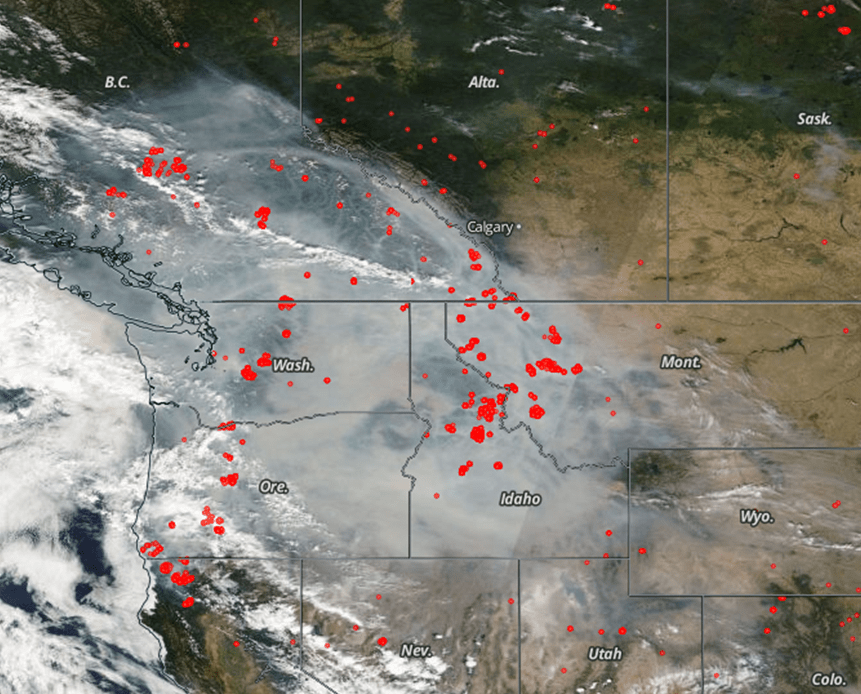City officials in Seattle have invested in 5 facilities with free clean and cool air for residents if and when wildfires fill local skies with smoke this summer. A recent article in the Washington Post online describes Seattle’s new program. Seattle is retrofitting 5 facilities that had central cooling with advanced air filtration systems. These systems will be able to filter out microscopic particulates that are especially dangerous for children, elderly people, and those with heart or respiratory conditions. Indoor air sensors will also be installed in the city facilities to measure the air quality. Dan Jaffe, Alex Margarito-Lopez (recent UW Bothell graduate), and Rebecca Rickett (UW Bothell student) will be working with the city to interpret data from these sensors.
In the past two summers, Seattle experienced increased air pollution from wildfire smoke, including 4 days last summer that reached levels of fine particulate matter that were unhealthy for all individuals. Most homes in Seattle do not have air conditioning or air filtration systems. Many residents rely on opening the windows to cool their homes in the summer. When the outside air is polluted with smoke, opening windows leads to a house filled with polluted air. The new clean air centers will offer residents somewhere to go to get out of the polluted air.
Wildfires in the West have been increasing in recent years. A major factor in the worsening wildfire picture is human-driven climate change, which is causing drier and warmer conditions. Seattle Mayor Jenny Durkan recognized that local governments need to step up “to be ready for the climate changes we’re experiencing in Seattle.” These centers are part of an effort to address climate change’s impacts.
The wildfire outlook is “strong wildfires, much larger than normal,” Dan Jaffe says. “It’s going to get worse. How much worse we don’t know, but we need to adapt. Whether that’s thinking about clean air, cool spaces to go to during the daytime, or whether that means shoring up beaches, or whatever it means, communities across the country need to adapt to climate change.”

 In November, Dr. Praphulla Chandra Boggarapu joined the Jaffe Group as a postdoc research associate. Praphulla grew up in Vizag, Andhra Pradesh, India, and is new to the Seattle area. He received his Ph.D. from the Indian Institute of Science Education and Research (IISER) in Mohali, India. His dissertation was titled “Measurements of reactive Volatile Organic Compounds (VOCs) and their emissions in agricultural and urban atmospheric environments of the Indo-Gangetic Plain (IGP)”
In November, Dr. Praphulla Chandra Boggarapu joined the Jaffe Group as a postdoc research associate. Praphulla grew up in Vizag, Andhra Pradesh, India, and is new to the Seattle area. He received his Ph.D. from the Indian Institute of Science Education and Research (IISER) in Mohali, India. His dissertation was titled “Measurements of reactive Volatile Organic Compounds (VOCs) and their emissions in agricultural and urban atmospheric environments of the Indo-Gangetic Plain (IGP)”

 Let me introduce you to our newest graduates, Dr. Crystal McClure and Dr. Pao Baylon! A few raindrops didn’t diminish their sunny smiles and the cheering crowd as they marched at the University of Washington’s graduation on June 9, 2018. We celebrate your success and are so excited for both of you!
Let me introduce you to our newest graduates, Dr. Crystal McClure and Dr. Pao Baylon! A few raindrops didn’t diminish their sunny smiles and the cheering crowd as they marched at the University of Washington’s graduation on June 9, 2018. We celebrate your success and are so excited for both of you!